New York Center for Facial Plastic Surgery
Schedule a consultation
Schedule today

Information About the Lower Eyelid Lift, Also Known as Lower Blepharoplasty
Watch the Journey: Life-Changing Lower Blepharoplasty: A 43-Year-Old Woman’s Journey with Dr. Andrew Jacono. See her facelift before and after transformation.
Lower blepharoplasty rejuvenates aging eyelids. As we get older, the lower eyelids change, making people look older, sadder, and more tired.
With time, eyelid skin loosens, which creates wrinkles and crow’s feet. The orbicularis oculi muscle, found around the eye, also becomes looser and “festoons.” The eyelids become puffy with excess fat pockets, and dark circles form as volume is lost in the upper cheeks. The outer corner of the eye, called the lateral canthus, can also droop, making the eyes appear round.
Not everyone develops these problems, so Dr. Jacono tailors every blepharoplasty to the patient’s individual needs.
Common Reasons to Have a Lower Eyelid Surgery Include:
Younger patients tend to rejuvenate their eyelids non-surgically. Dr. Jacono injects hyaluronic acid filler in the tear troughs beneath the eyes, which camouflages puffy lower eye bags. Botox can also smooth eyelid wrinkles. Non-surgical eyelid lifts last between 6 and 12 months.
Non-surgical rejuvenation works best for patients in their forties. As we continue to age, however, the eyelid bags become too large to treat with filler. The lower eyelid skin also becomes too loose to smooth with Botox.
In these cases, Dr. Jacono recommends surgical blepharoplasty of lower eyelids. The results of this procedure last 15 years or more and are more dramatic. The cost of repeated injections over the course of ten years is about 3 to 4 times that of lower eyelid surgery. Surgery can thus be more cost-effective.
The bags under the eyes can be approached through an incision placed inside the eyelid called a transconjunctival blepharoplasty or just below the eyelashes called a transcutaneous blepharoplasty. The decision to make the external incision depends upon how much skin needs to be removed.
Once incisions are made, Dr. Jacono removes excess skin, muscle, and fat. This tightens the eyelids, eliminates wrinkles, and adds volume. Lower blepharoplasty can be completed under local or twilight anesthesia.
Dr. Jacono does not use general anesthesia for this surgery, as it increases the risk of pain and complications. After treatment, incisions heal quickly and are virtually invisible.

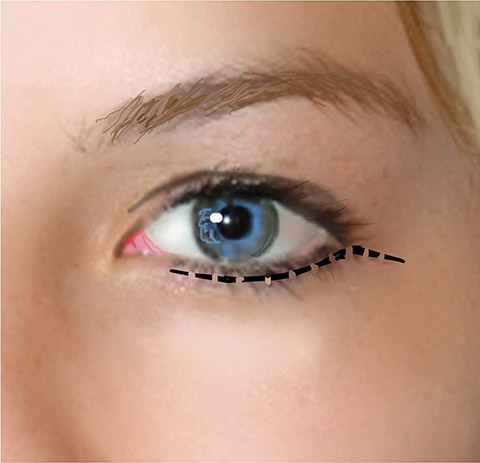
Instead of removing the fat bags under the eyes which creates a hollowed-out, plastic, and “done” look, Doctor Jacono transposes the orbital fat down into the tear trough. This is the hollowed area underneath the eyes that creates dark circles. In this way, both bags are removed and the hollows are filled in one procedure.


Canthopexy Procedure. Dr. Jacono often tightens the lateral canthal tendon of the lower eyelid. This prevents the lower eyelid from changing shape after a lower blepharoplasty. It can also recreate the almond-shaped eyes of youth.
A common complication of lower eyelid surgery is a change in eyelid shape. Sometimes, the corner of the eye drops. This is called ectropion. Dr. Jacono regularly performs revision lower eyelid surgery and knows how to prevent this problem with a procedure called a canthopexy.
During surgery, Dr. Jacono strengthens a tendon in the eyelid called the lateral canthal tendon. This ensures that the eyelid does not droop while it heals.
Some patients suffer from excess skin, loose muscles, and eyelid hollowing, but do not develop fat bags. Others may have had a previous surgery that removed too much fat.
In these cases, Dr. Jacono performs a procedure called a lower blepharoplasty with fat transfer. He removes fat from the abdomen, hips, or thighs and injects it into the tear troughs. This fat is not as smooth as the fat from the eyelids, but it is the next-best option.
Once the fat has been injected, skin and muscle are tightened for the best results.
If you suffer from wrinkled, puffy lower eyelids, surgery is a great option. Blepharoplasty is a relatively quick, simple procedure that can make patients look years younger. It can also save patients money if they choose surgical intervention over repeated non-surgical solutions.
Lower eyelid blepharoplasty surgery takes approximately one hour to perform, but lower blepharoplasty recovery can take approximately ten days to two weeks. Bruising from lower eye blepharoplasty surgery lasts between 7 and 10 days, though Dr. Jacono prescribes special makeup to cover bruises.
Lower blepharoplasty recovery time will be shortened if you follow all of Dr. Jacono’s instructions to the letter and allow your body the chance to heal completely and correctly.
After the recovery healing process, the lower eyelids will look much smoother and fuller.
Lower lid blepharoplasty cost can vary widely depending on the circumstances and nature of the surgery. To get a better picture of the surgery’s cost of lower blepharoplasty, contact us for an evaluation.
Men and women who have puffy bags under their eyes may be a candidate for lower blepharoplasty. The best candidates are in good physical health, are non-smokers, and are willing to follow post-surgical instructions.
You can schedule an in-person consultation with Dr. Jacono at one of his 2 New York locations. Please fill out an online consultation form, and one of his patient coordinators will assist you. Alternatively, you can call his New York City location at 212-570-2500, or his Long Island center at 516-773-4646.
Dr. Jacono is double board certified with the American Society of Plastic Surgeons and the American Academy of Facial Plastic and Reconstructive Surgery, specializing in facial cosmetic surgery, and is considered the best facial plastic surgeon in New York City.

This woman in her late forties had tired looking eyes with large bags and lateral canthus (outer corner of eye) rounding that happens with age. Doctor Jacono performed a fat transposition lower eyelid lift moving the fat bags under the eyes into the tear troughs. He also performed a canthopexy to tighten the drooped corner of the eye recreating a more youthful almond shaped eye.

This woman in her late forties wanted to lift her drooping cheeks and nasolabial folds and recreate a tighter jawline and get rid of her jowls. She had a mini facelift with a deep plane facelift of her fallen facial musculature. A short scar facelift incision was used so the incisions are hidden on the inside and behind the ear so the hair can be worn up with a ponytail. She has her upper eyelid lift and lower eyelid lift with a fat transposition to fill her under eye circles performed at the same.
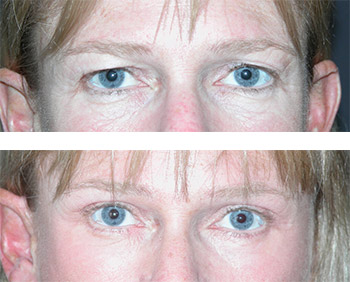
This patient in her late forties is a sun worshipper with fair skin that developed significant wrinkling and excess skin. In addition to repositioning her orbital fat, he needed to remove a large amount of excess skin requiring an external incision under the eyelashes. The incisions heal well in just a few weeks as you can see in this picture.
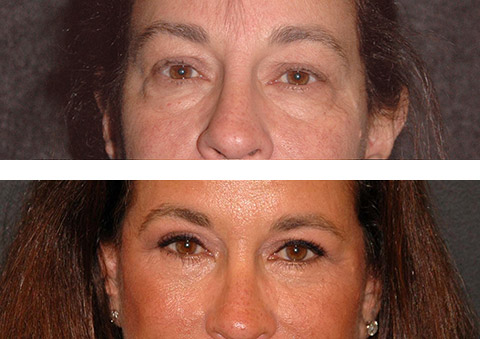
This woman in her 50s had bags under her eyes and hollowing in her upper cheeks. Doctor Jacono performed a transconjunctival fat transposition to fill her tear trough and remove her lower eyelid bags.
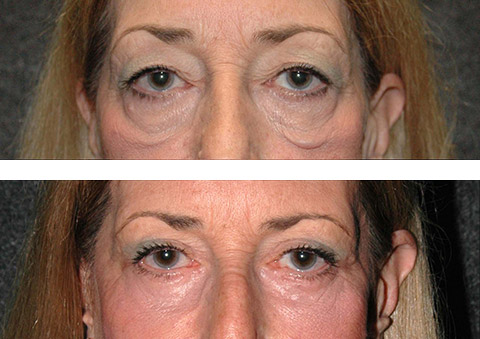
This woman in her mid 60s had more significant drooping of the eyelid muscles called festooning. To repair this Doctor Jacono performed a transcutaneous blepharoplasty with a skin muscle flap to target the excess muscle, lift and remove it smoothing excessive festoons. Many plastic surgeons do not repair festoons as it is a more complex muscle repair.
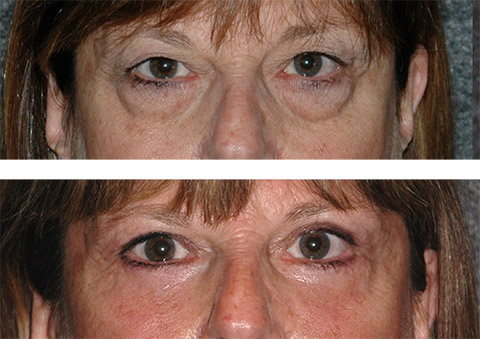
This woman in her late fifties had large orbital fat pockets. Doctor Jacono removed some of this fat and transposed the remainder to the tear trough. Her eyelid muscle was drooping as well so he performed a skin muscle flap to redrape and remove the excess muscle.

This woman in her 60s had hollowed eyes with aging but had no eyelid fat to fill her tear trough. Doctor Jacono performed a fat graft injection to fill the sunken eyes as well as tightened loosening eyelid muscle and removed excess skin. The result is more youthful appearing eyes.
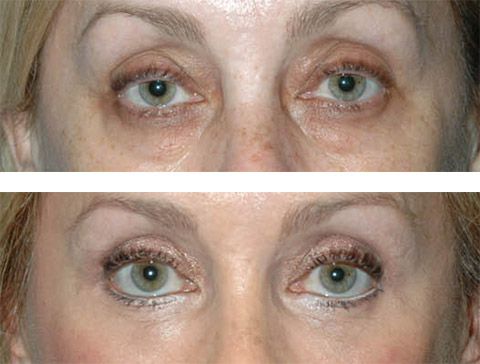
Dr. Jacono performed a deep plane facelift and a lower blepharoplasty to address her concerns. Dr. Jacono also repositioned the lower eyebags to reduce the appearance of her dark eye circles. Her after photos show her cheeks have been lifted to reverse the drooping affect and the hollows under her eyes were smooth and filled. She looks natural and decades younger.
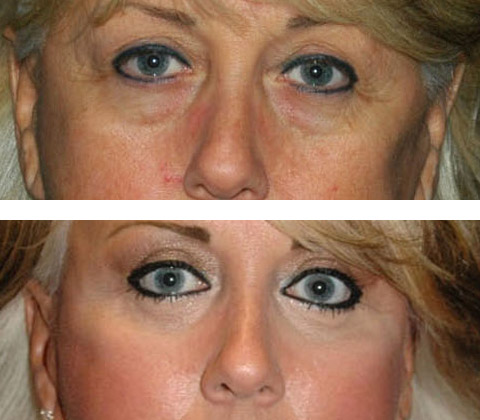
This patient is 1-year post-operative and in her early fifties. She wanted to look younger and more rejuvenated. Dr. Jacono performed a deep plane facelift procedure combined with a neck lift, platysmaplasty, lateral temporal lift and a lower blepharoplasty with orbital fat transposition. Her after photos show her looking natural and refreshed. Not pulled or too tight.
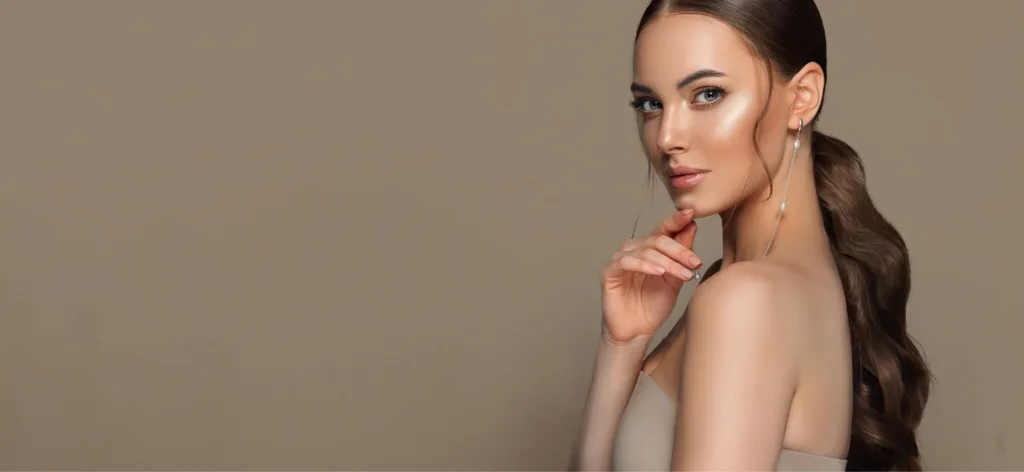
Accessibility: If you are vision-impaired or have some other impairment covered by the Americans with Disabilities Act or a similar law, and you wish to discuss potential accommodations related to using this website, please contact our Accessibility Manager at (212) 570-2500 .